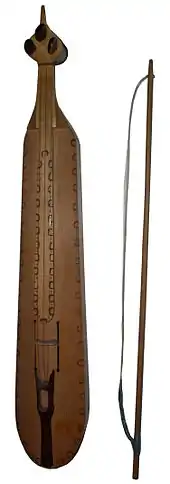
.jpg.webp)
Kemenche (Turkish: kemençe) or Lyra is a name used for various types of stringed bowed musical instruments originating in the Eastern Mediterranean, particularly in Greece, Armenia, Iran, Turkey, and Azerbaijan.[1] and regions adjacent to the Black Sea. These instruments are folk instruments, generally having three strings and played held upright with their tail on the knee of the musician.[2] The name Kemenche derives from the Persian Kamancheh, meaning merely a "small bow".[3]
Variations
The Kemençe of the Black Sea (Turkish: Karadeniz kemençesi), also known as Pontic kemenche or Pontic lyra (Greek: Ποντιακή λύρα), is a box-shaped lute (321.322), while the classical kemençe (Turkish: Klasik kemençe or Armudî kemençe, Greek: Πολίτικη Λύρα) is a bowl-shaped lute (321.321).
Other bowed instruments have names sharing the same Persian etymology include the kamancheh (or Kabak kemane in Turkish), a spike lute (321.31), and the Cappadocian kemane, an instrument closely related to the kemenche of the Black Sea with added sympathetic strings. Though, Circassians of Caucasus also have the same instrument in their own language named as Shikepshine which basically means horse tail violin.
See also
References
- ↑ McCollum, Jonathan (2014). "Kamancha." New Grove Dictionary of Musical Instruments. Second Edition. Oxford University Press. ISBN 9780199743391.
- ↑ Hugo Pinksterboer, Tipbook: Cello (2002), p. 106.
- ↑ "Middle East Focus" (PDF). TheStrad.com: 50–52. July 2007.
The Persian word for bow is kaman, and kamancheh is the diminutive form.